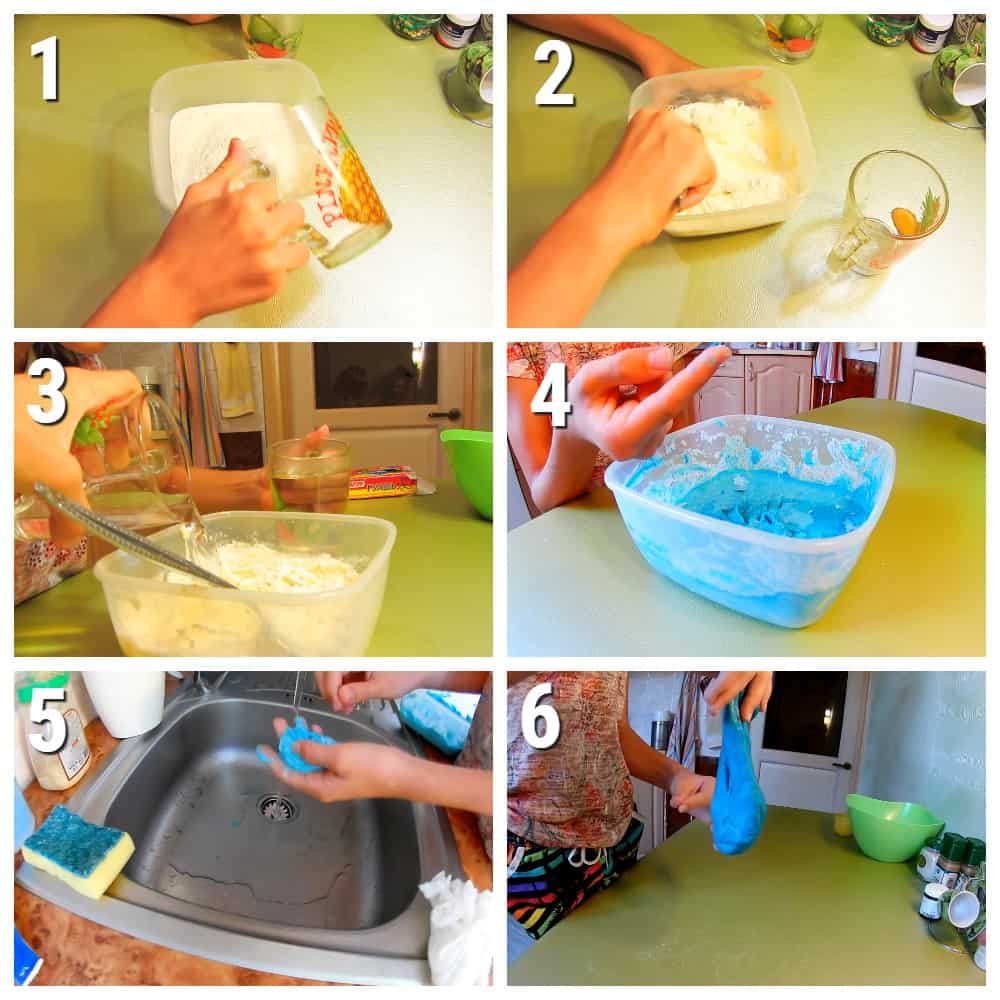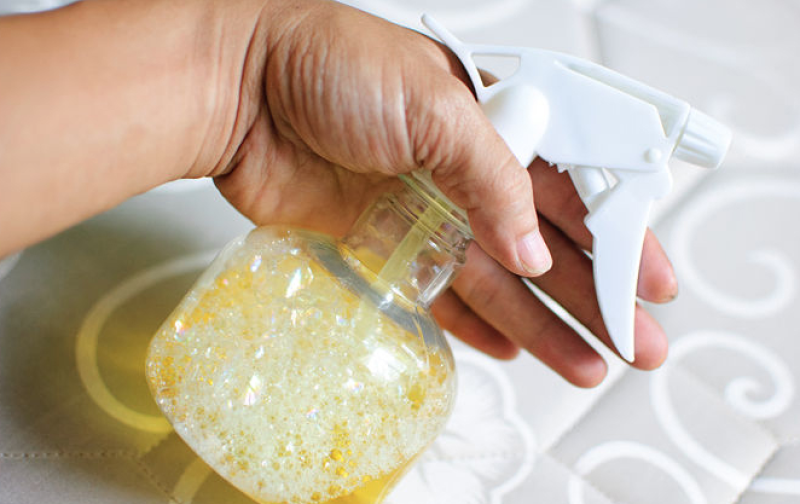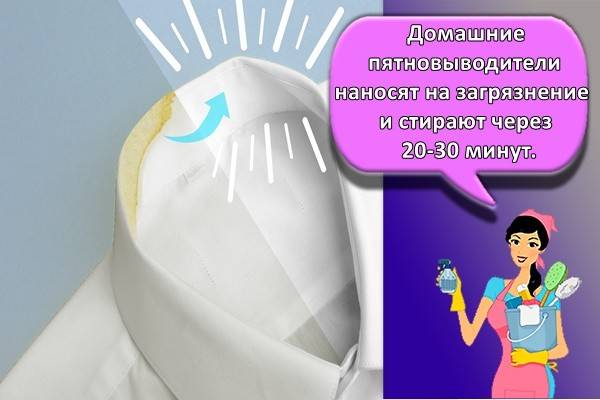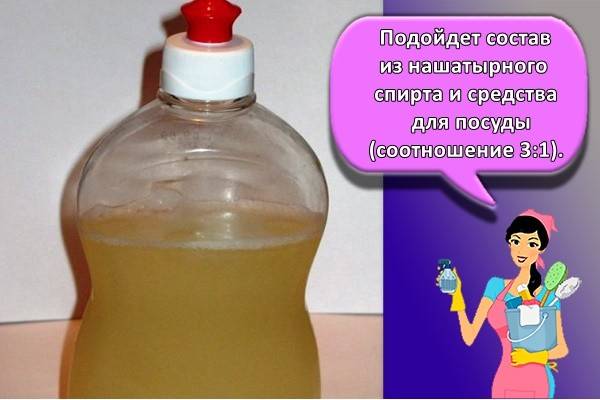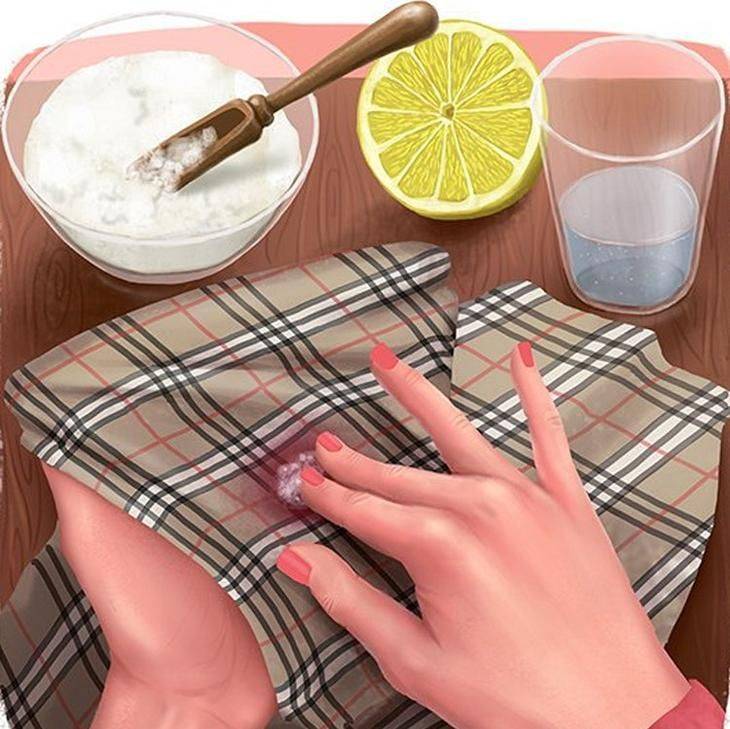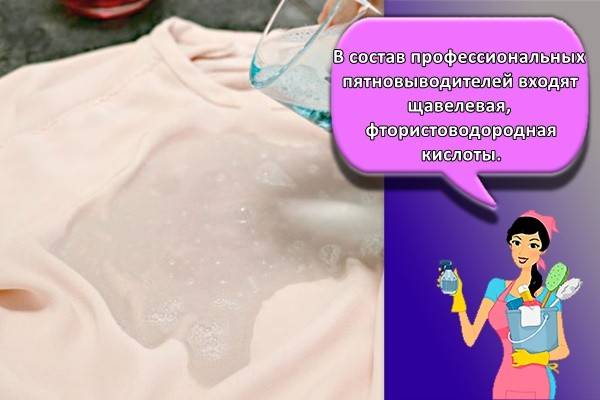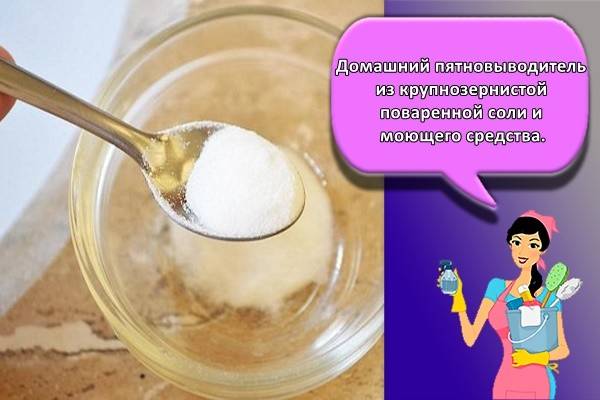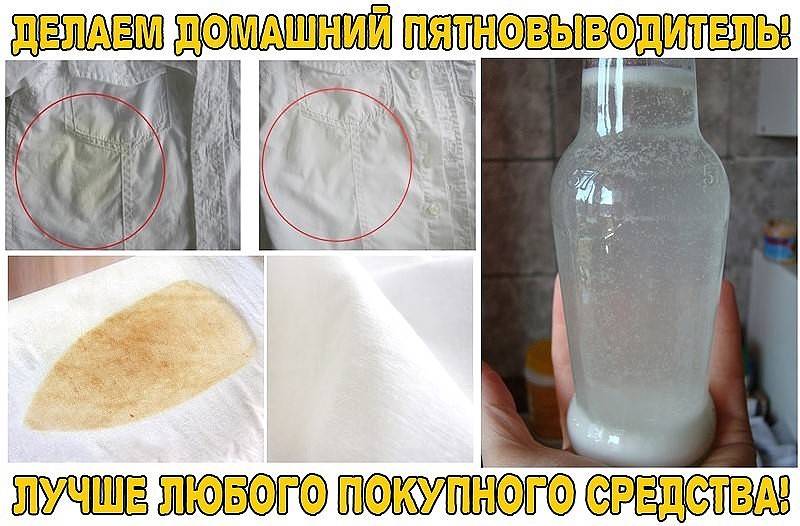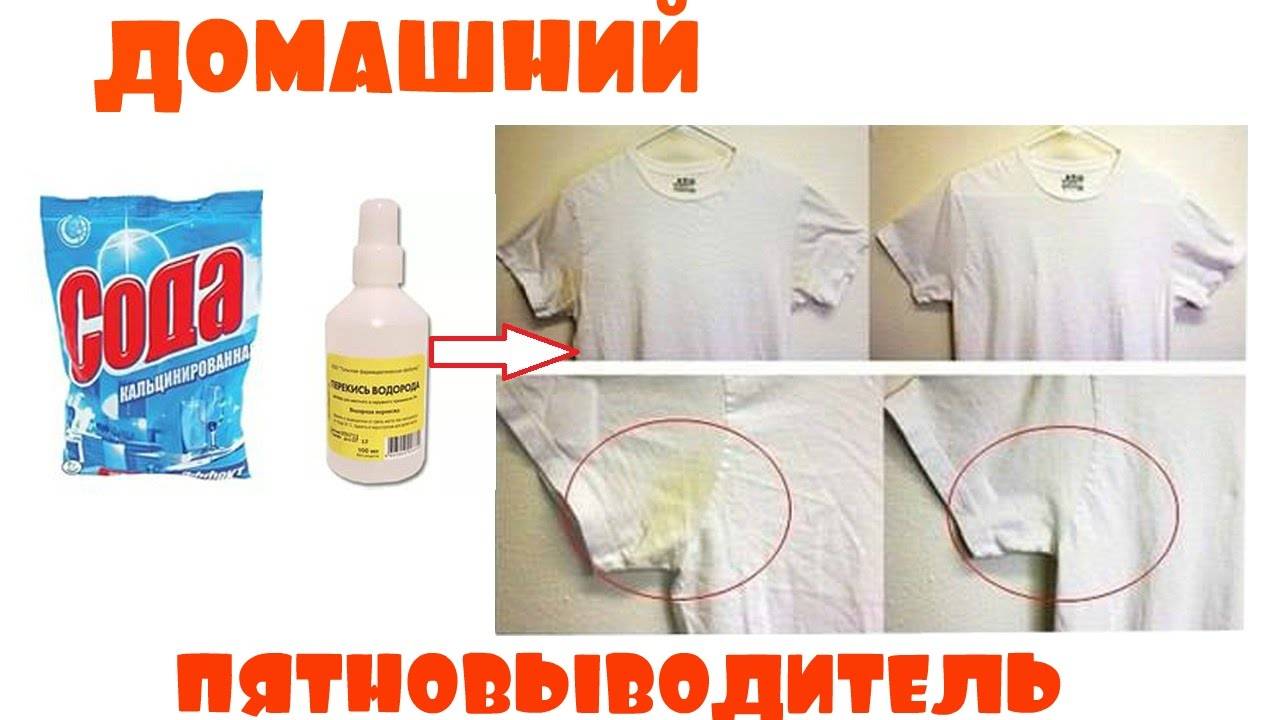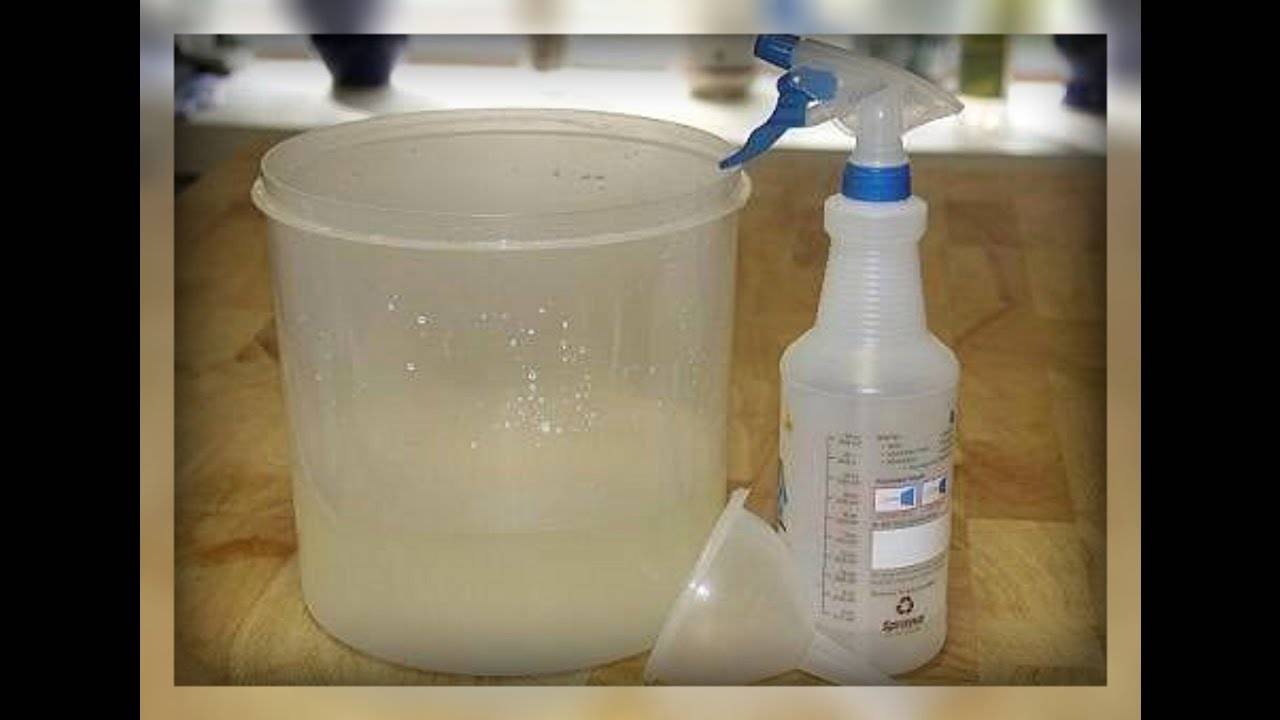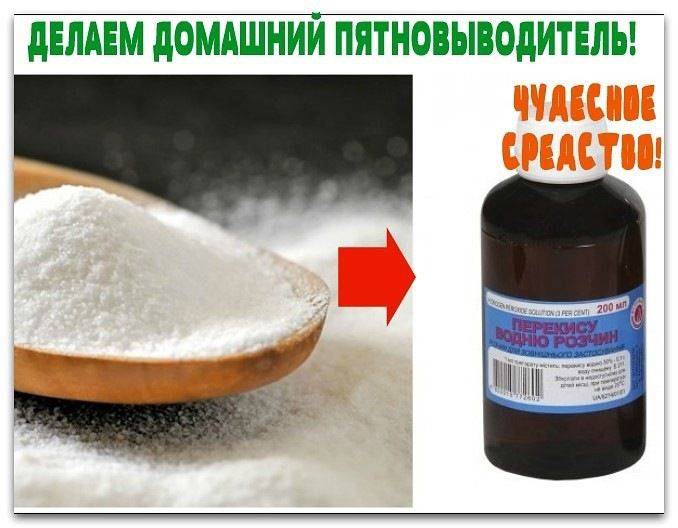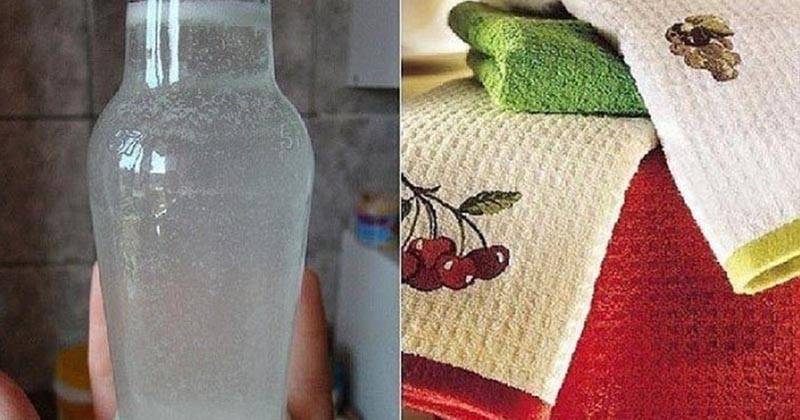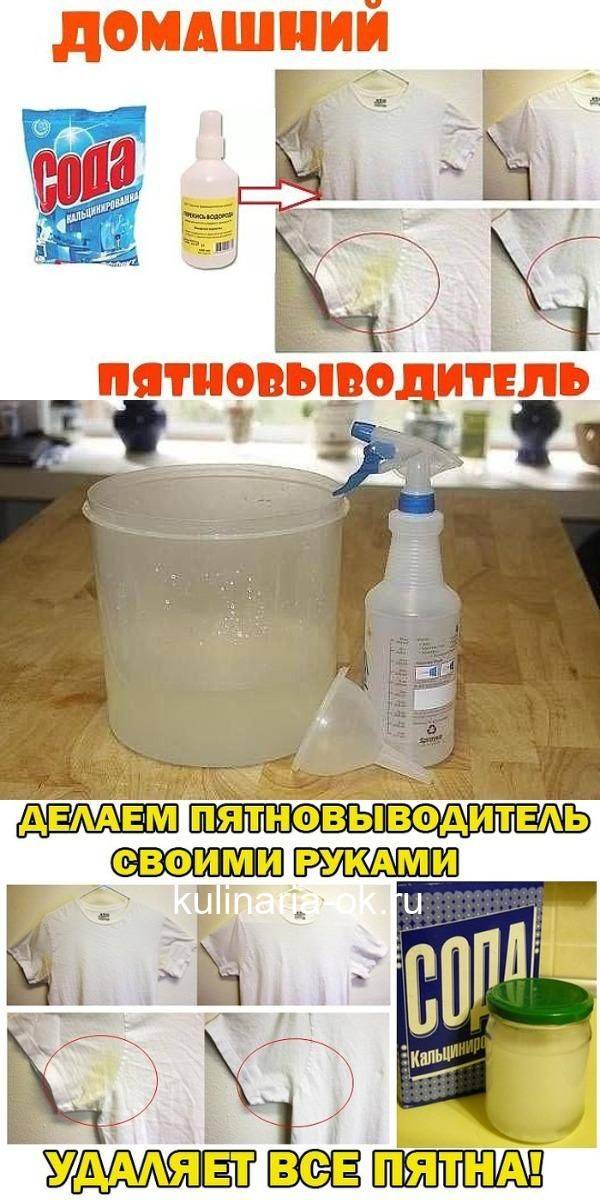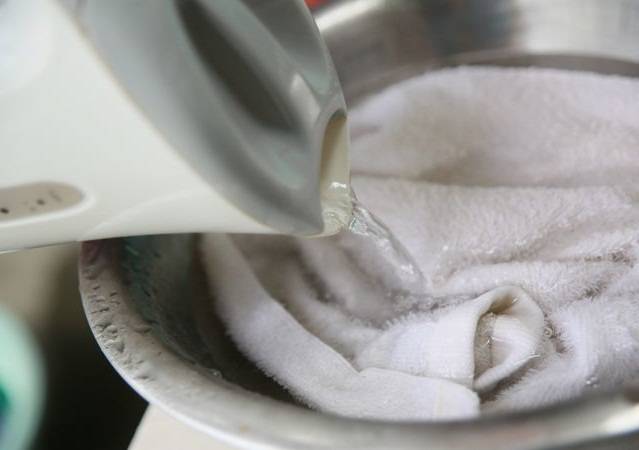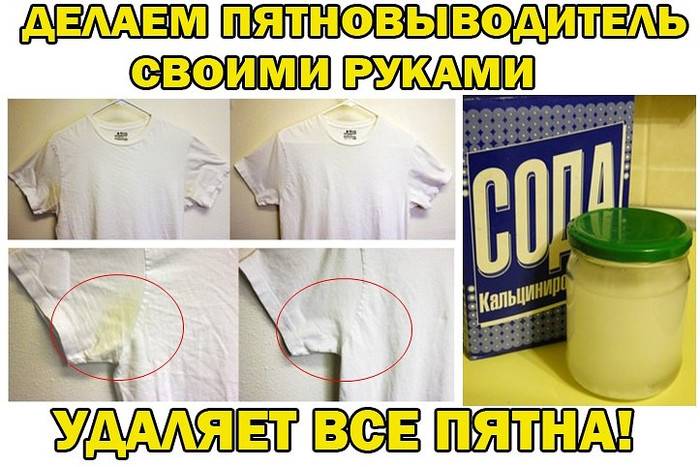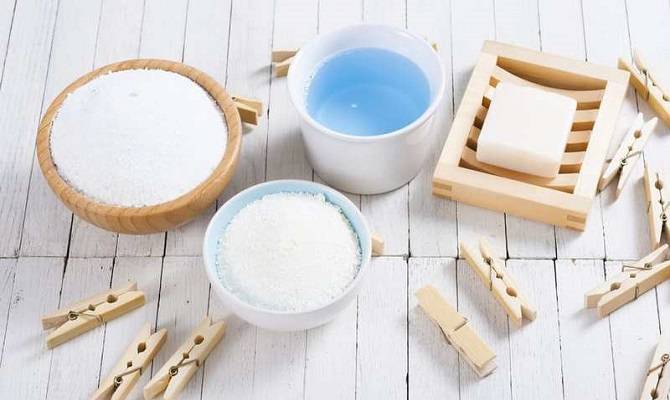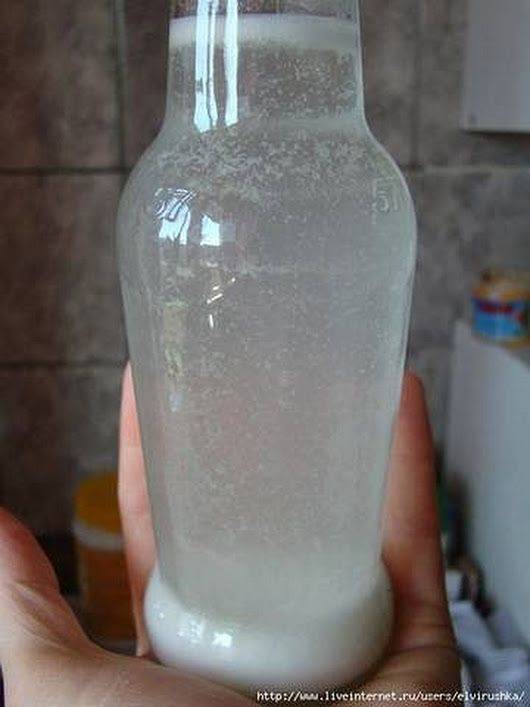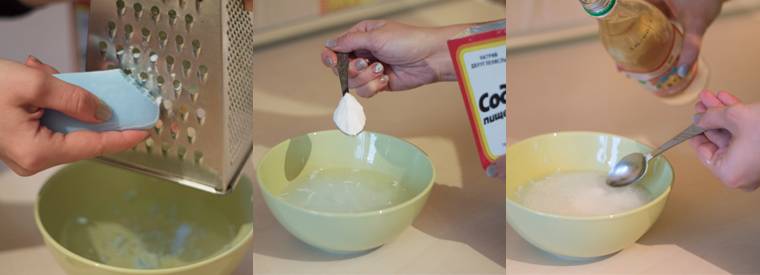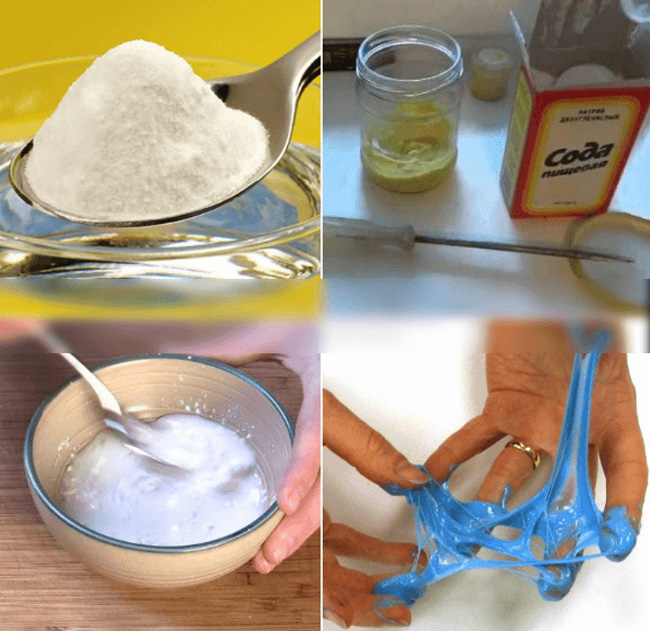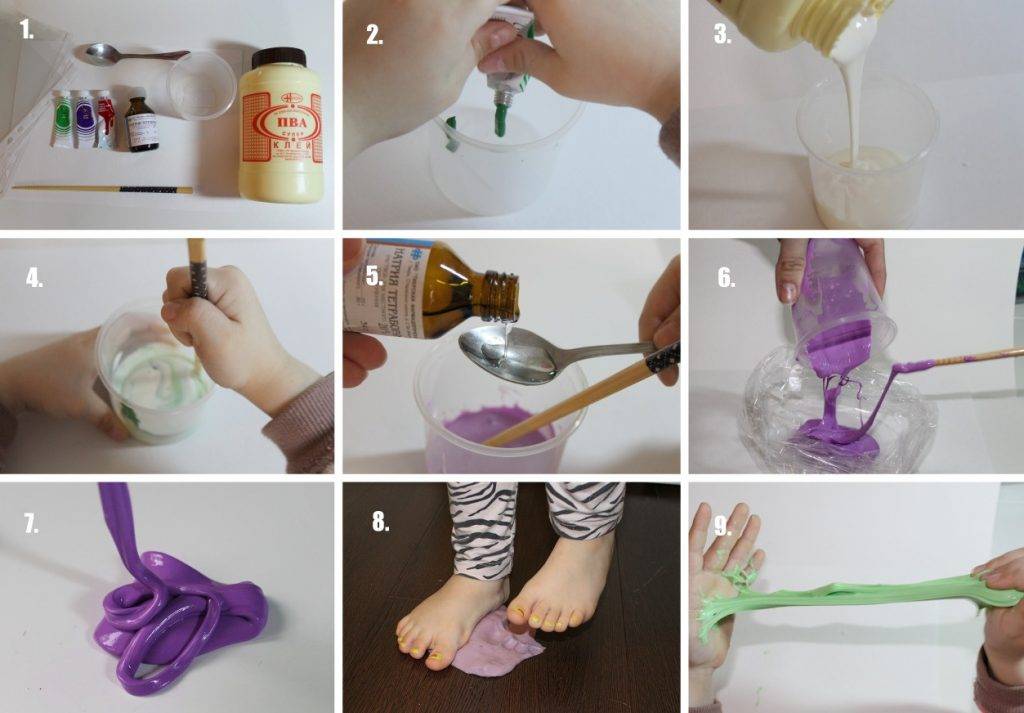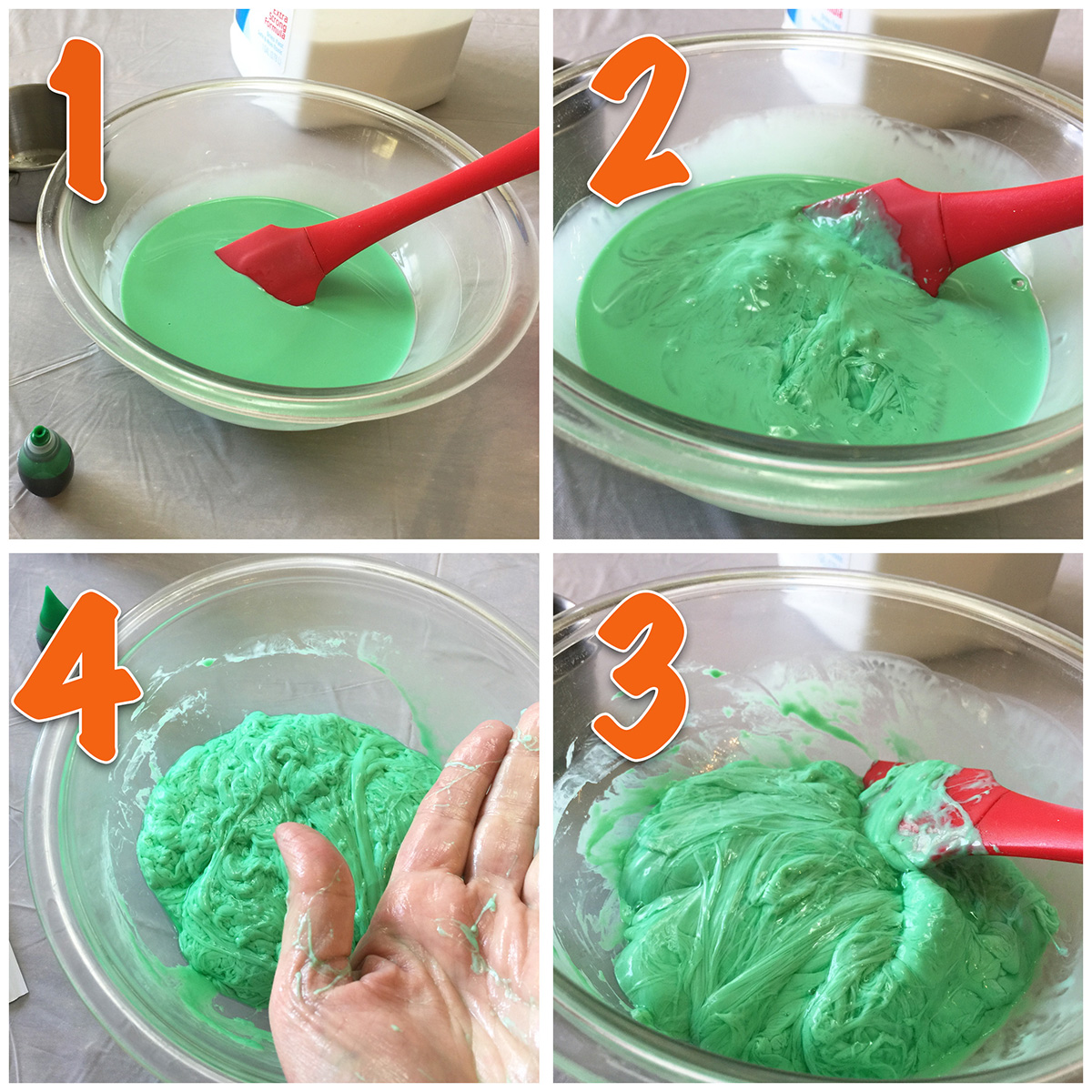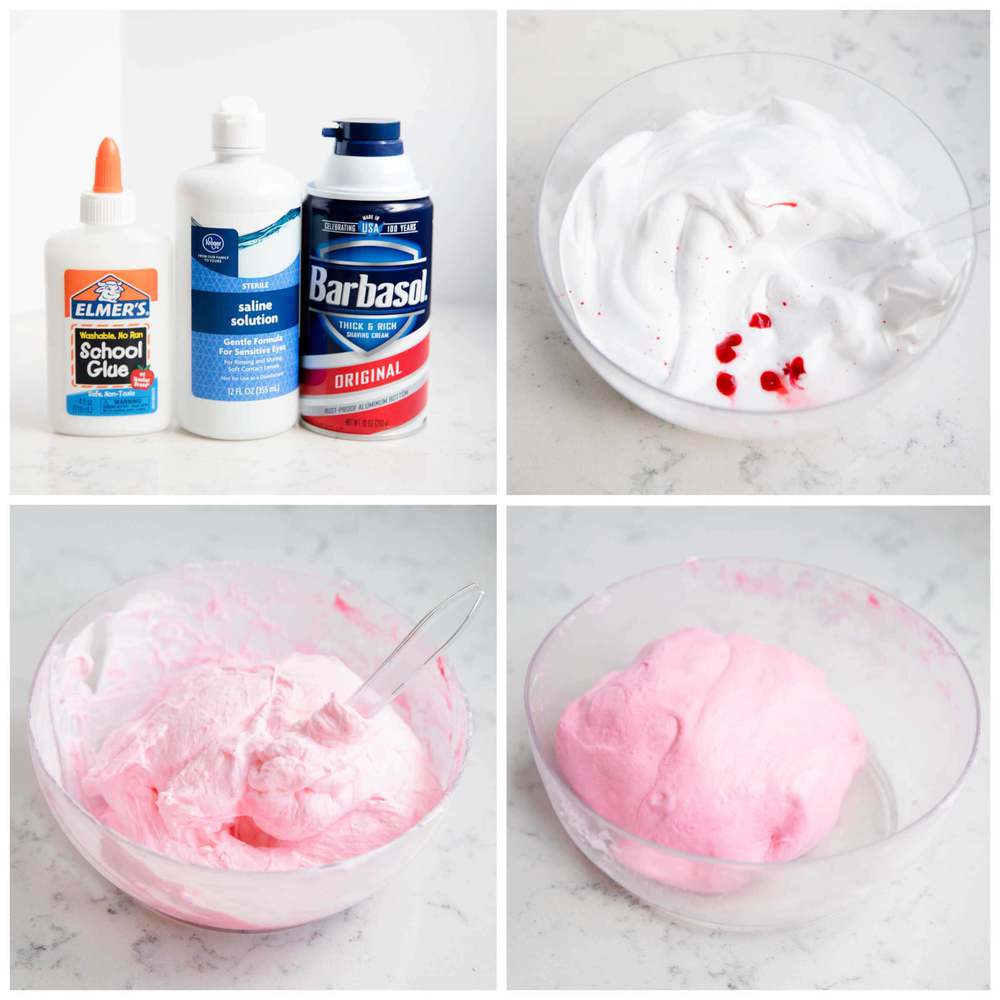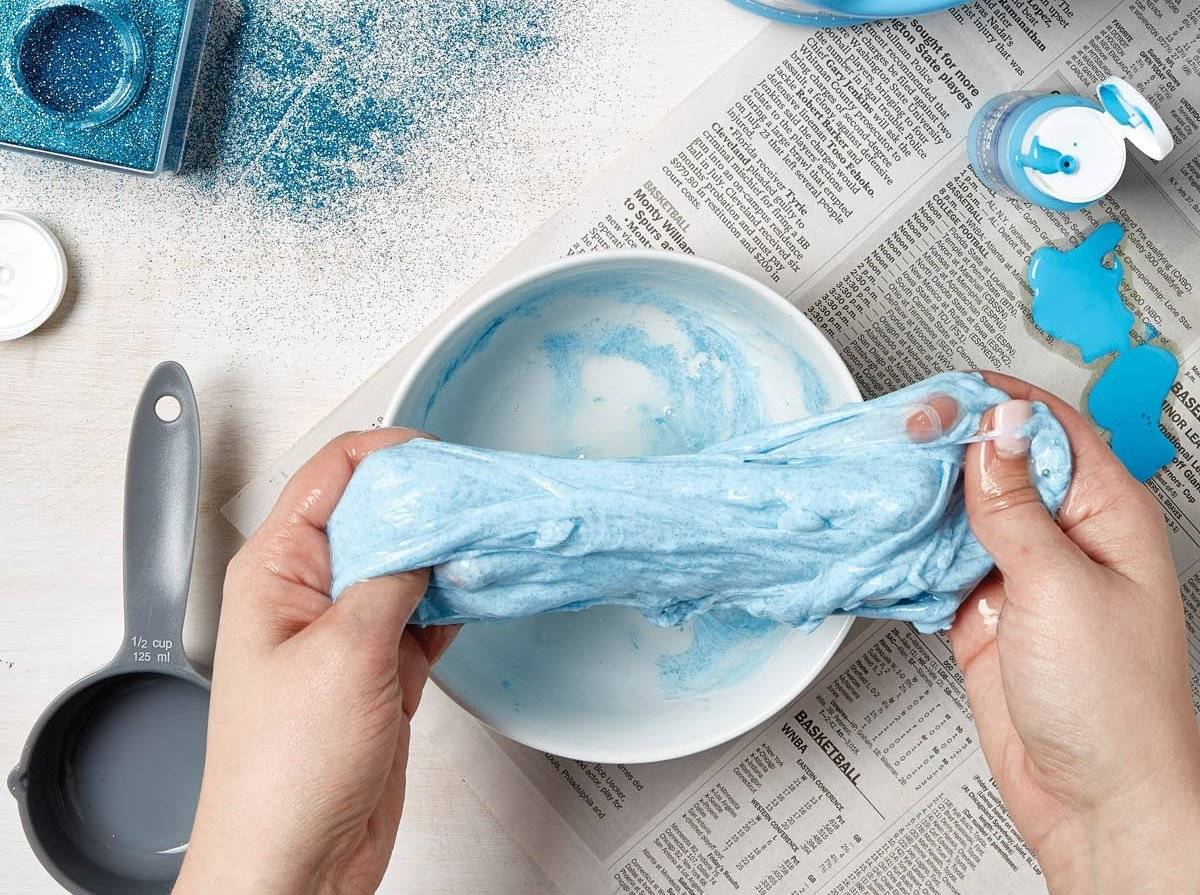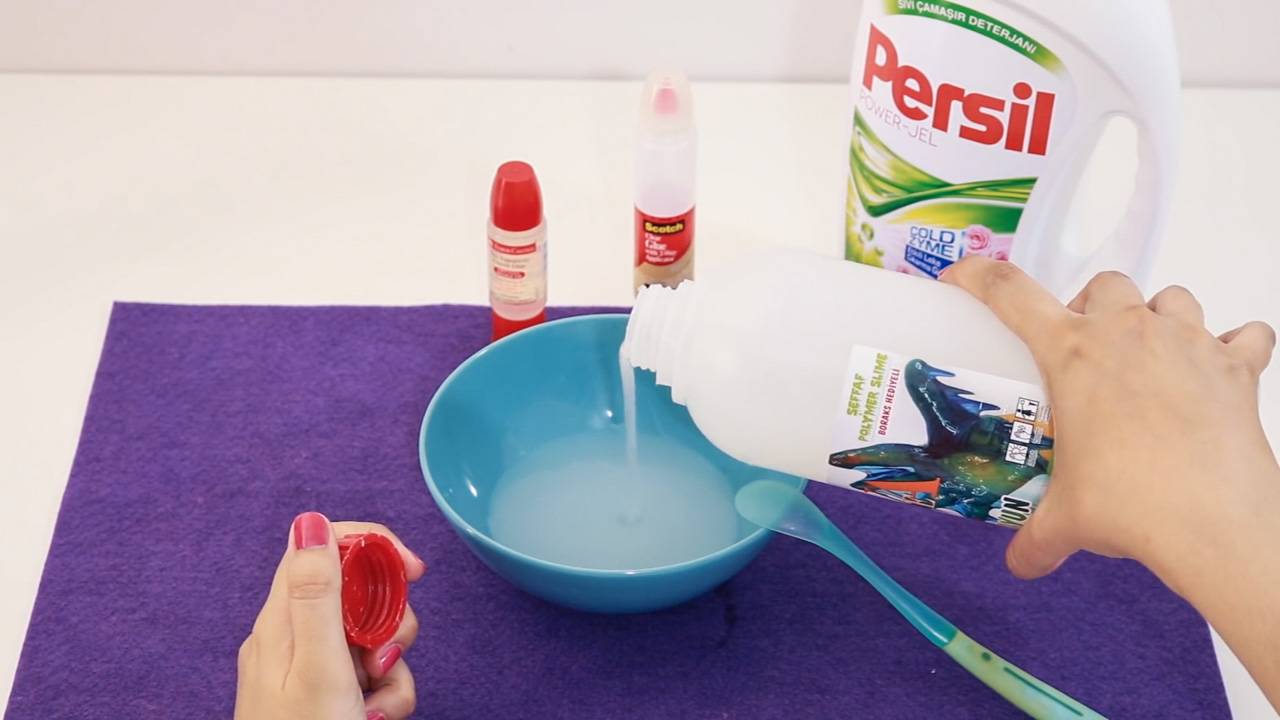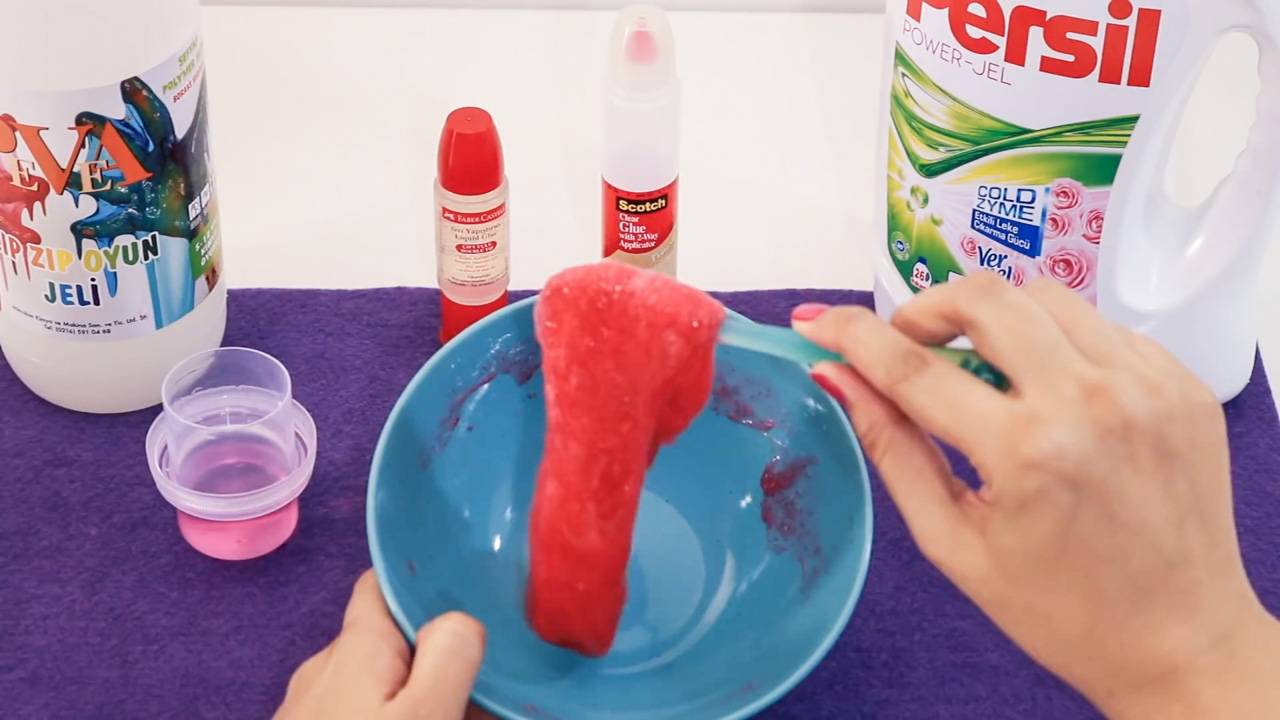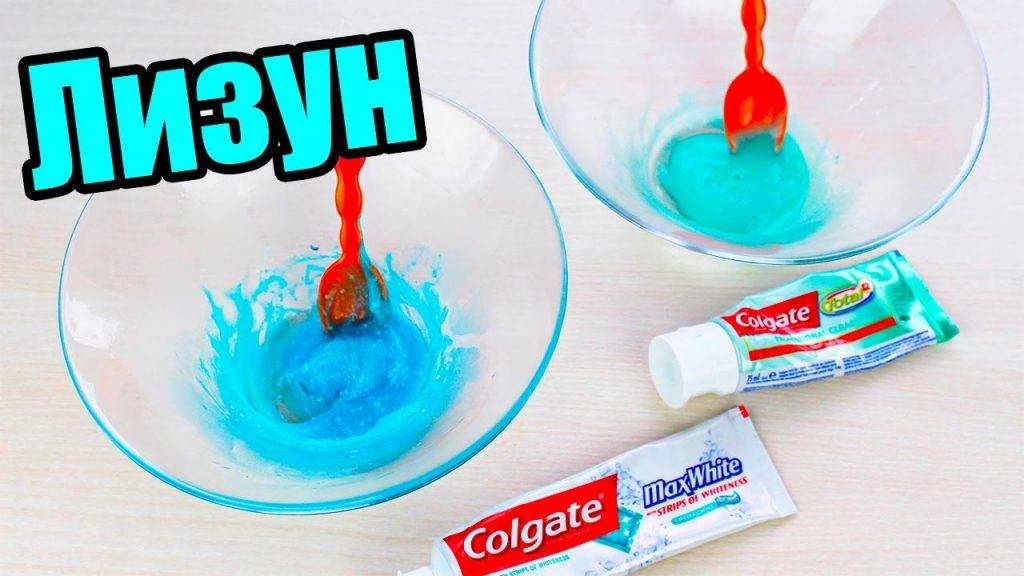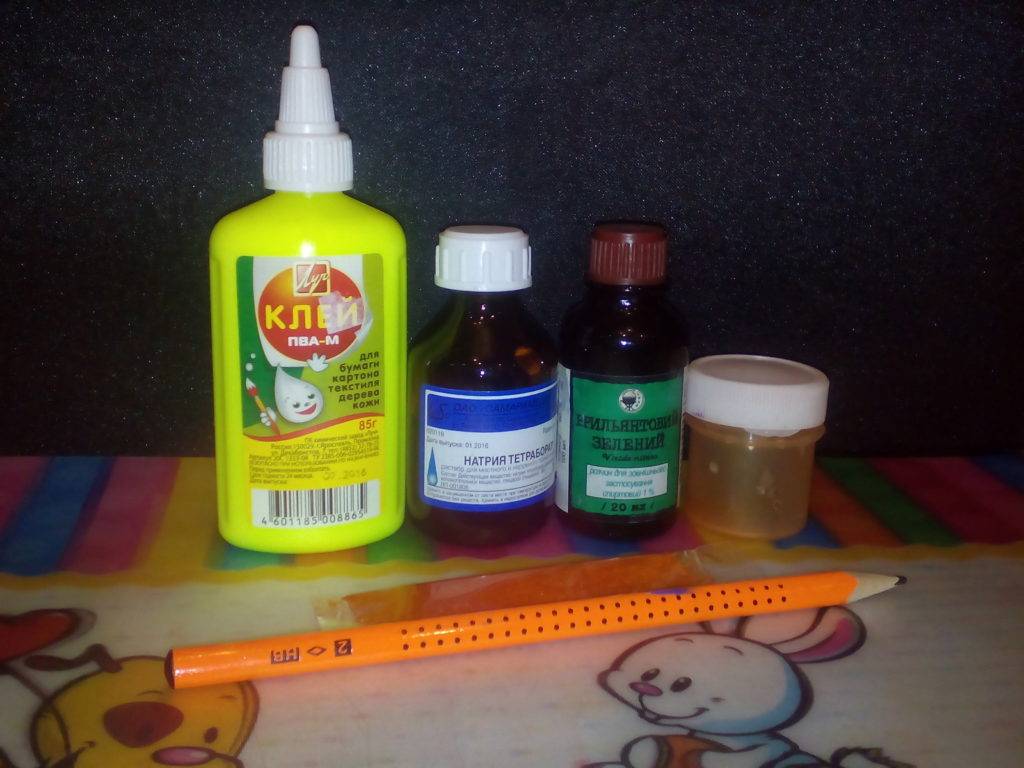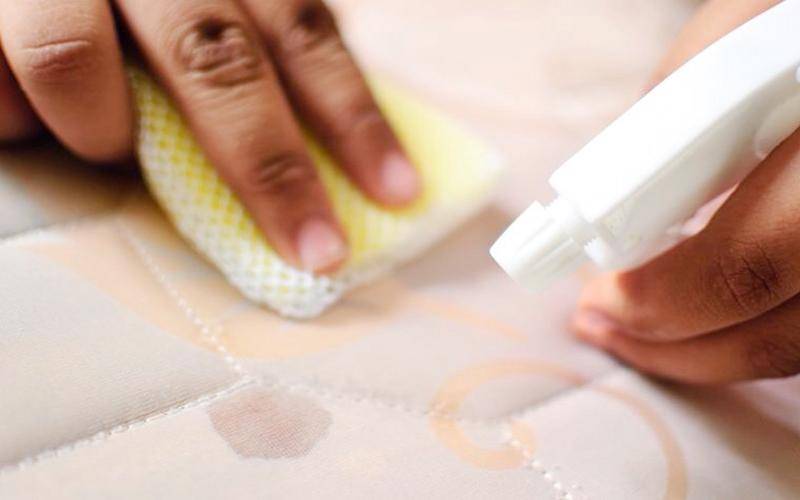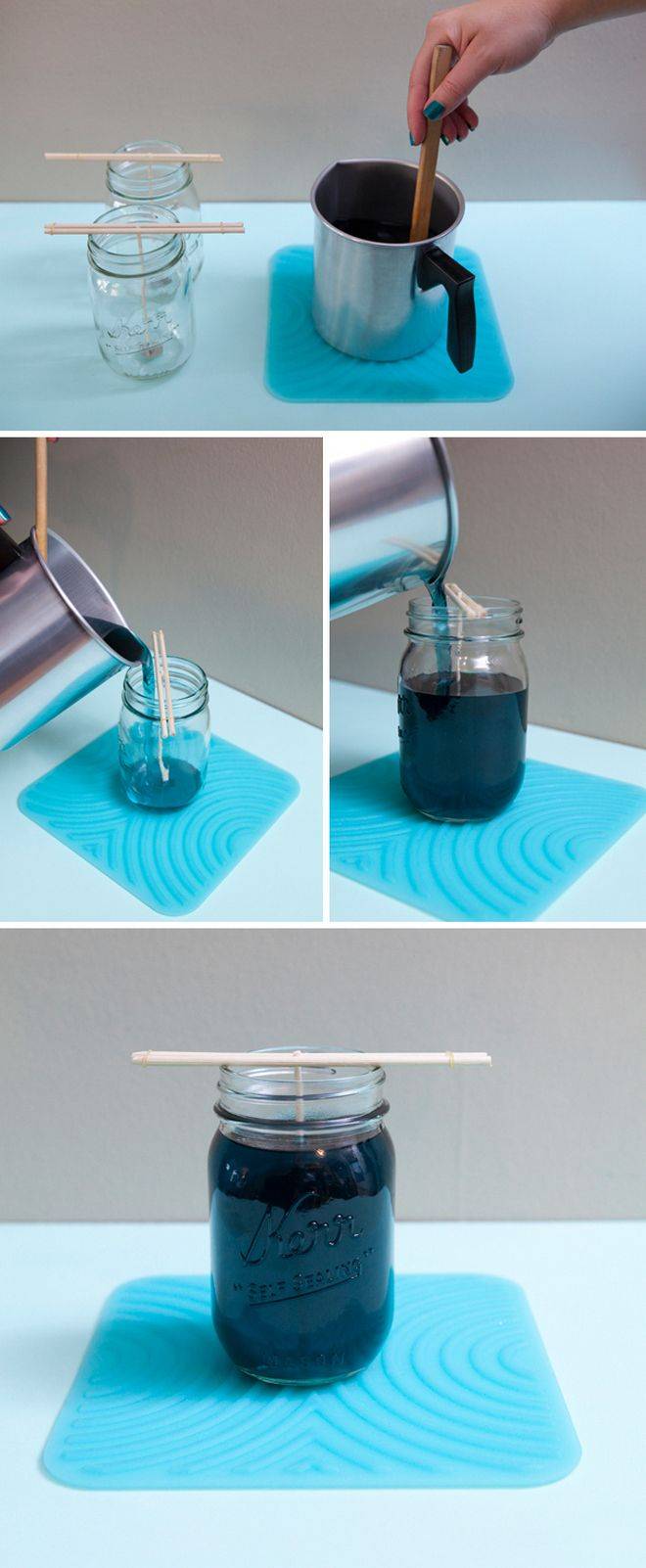Varieties and methods of replacing them
The choice of stain remover depends on the composition of the stain. The principle of operation is the destruction of organic or inorganic compounds and removal from the tissue.
3> Chlorine
Chlorine compounds such as Whiteness are used to bleach white cotton and linen products. At home, it can be replaced with a solution of bleach. Enough 30 grams per 1000 milliliters.
The use of a home stain remover has the same limitations and disadvantages as the professional method:
- premature wear of the fabric;
- yellowness on a white background;
- odor and solution toxicity;
- use on fabrics with a dense, natural structure.
The use of chlorine compounds requires skin protection and ventilation.
Peroxide
Special stain removers contain oxygen, which oxidizes organic components of pollution. At home, replacements for store stain removers are hydrogen peroxide and soda ash. A pharmaceutical disinfectant will also replace chlorine-based bleach.
Perhydrol when interacting with water decomposes into oxygen and carbon dioxide. Soda ash softens the water, making it easier to clean the fabric. For greater effect, the water temperature should be 70-80 degrees. For silk, wool, the temperature is reduced to 30-50 degrees. Do not use home stain remover on colored fabrics
Chemicals require careful handling, excluding contact with mucous membranes, in the gastrointestinal tract
Acid
Professional stain removers contain oxalic and hydrofluoric acids. They are used to remove iron oxides from cotton items. High toxicity and aggressiveness limits their use.
Table vinegar, artificial citric acid, lemon juice have similar properties in terms of interaction with inorganic substances.
Universal remedies
To remove stains from colored fabric so that after home dry cleaning there are no faded areas on it, you can use a product that includes:
- green tea;
- laundry soap (preferably brown);
- soda ash;
- water.
Soda ash (sodium carbonate) is different from baking soda (sodium bicarbonate)
The first is chemically more active, therefore it is necessary to work with it, taking precautions, since, getting on the skin and mucous membranes, soda ash can cause at least irritation

We recommend that you familiarize yourself
The process of preparing the stain remover is as follows:
- 1¼ bar of soap is turned into shavings (with a knife or grater). It is poured into a saucepan with 1 liter of water. The mixture is boiled until the soap is completely dissolved.
- 2Add ½ cup of freshly brewed and strained tea and 3 tbsp. l. soda.
- 3 After thoroughly mixing the components, remove the pan with the prepared composition from the stove.
- 4 The agent cooled to room temperature (½ cup) is poured into the washing machine.
To clean white things, it is better to use a stain remover made from taken in equal proportions:
- water;
- baking soda;
- hydrogen peroxide (3%).
Soda is added to hot water. Then peroxide is poured into the solution. It is recommended to spray the resulting product over the contaminated area. Already 8-10 minutes after treatment with a stain remover, white items can be sent to the washing machine, however, in order to effectively remove long-planted stains, the reaction time of the product with contamination must be increased to several hours.
You can remove traces of chocolate or cocoa, rust or fat left on clothes with a composition made from:
- liquid detergent for dishes;
- ammonia;
- baking soda;
- water.
To make it, you need to mix in a container with 400 ml of warm water 2/3 cup of detergent and ammonia, 6 tbsp. l. soda. The prepared mixture is poured into a spray bottle. Shake the contents of the bottle before spraying, as the components of the cleaning composition separate over time. The stain remover has the properties of a bleach, so it is best used for cleaning whites.
The following effective remedy includes:
- hydrogen peroxide (3%);
- lemon juice;
- water.
They can remove rusty, greasy stains, traces of grass from clothes, as well as clean furniture, plumbing fixtures and tiles from various kinds of dirt.
The mixture is able to return the snow-whiteness of the old fabric: it, treated with the product, just needs to be placed for a while in a place well-lit by the sun's rays.
Methods for removing dirt from colored as well as white things
Having stained clothes made of colored fabric, many are afraid to use a stain remover because it can ruin the thing. To prevent this from happening, try making a DIY stain remover for colored items by taking:
- a piece of laundry soap weighing 50 grams;
- 100-150 grams of green tea broth;
- 100 grams of soda ash;
- litere of water.
Rub the soap with a grater. Bring water to a boil. Then add the resulting shavings to it. Boil the resulting mixture, stirring constantly, until the soap is completely dissolved. Then pour soda there and pour in the green tea broth. Let the mixture cool. Pour it directly into the washing machine drum. About 100 grams of the resulting solution will be enough. Start washing.
To remove stains from white items you will need:
- half a glass of hydrogen peroxide;
- half a glass of soda (food grade);
- one glass of hot water.
Dissolve soda in a glass of hot water. Add peroxide. Pour the mixture into a prepared spray container. Apply the composition to a fresh stain for 10 minutes. If the item has been stained for a long time, then leave it after processing for 7-8 hours and only then wash it.
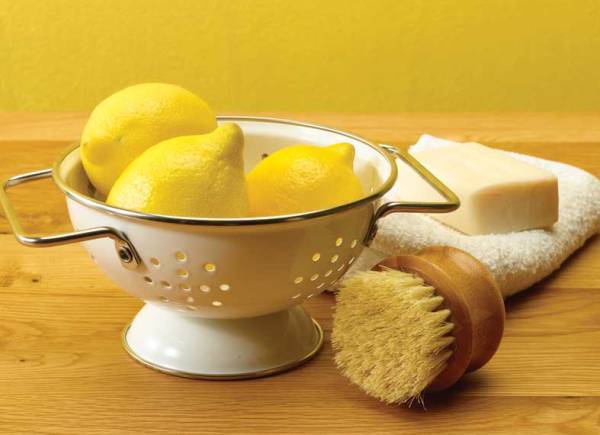
Do-it-yourself effective recipes for working with colored and white things
To achieve the result, multi-component stain removers are used. Thanks to the selected elements, the effect is enhanced and the effect on the fibers is softened.
First
The cleaning solution is prepared from dish detergent and 3% hydrogen peroxide. Ratio: 1: 2. Stain remover properties: oxygenated, with a degreasing and water softening effect.
Second
To obtain a mixture of 3% hydrogen peroxide, baking soda, dishwashing detergent, take the proportions: 8: 1: 4. Soda is used as a catalyst to enhance the oxidative effect. It is safe for the skin and removes organic odors.
Third
Homemade stain remover made from coarse table salt and detergent. Salt is highly hygroscopic and abrasive. Mixed with a degreaser, it removes well all types of staining stains: from wine to rust. On colored clothes, with an excess of salt, salt stains remain.
The concentration and amount of stain remover should be appropriate for the size of the stain. After cleaning, things are thoroughly rinsed in warm and cool water.
Fourth
Table vinegar (9%) (citric acid / fresh lemon juice) is mixed with table salt, baking soda and wiped clean. Ratio: 1 tablespoon of acid, 1 teaspoon of baking soda, ½ teaspoon of salt. Oxygen is released as a result of a chemical reaction. The effect of the home stain remover is short-lived: while the acetic acid and NaHCO3 react. The garment is washed and rinsed well so that the vinegar smell disappears.
Fifth
A solution of laundry soap with borax and ammonia will replace a special stain remover for colored and children's products.To obtain a liquid soap base, the laundry soap is grated and boiled until the shavings disappear. For 0.5 liters of boiling water - 1 bar of soap. The resulting emulsion is cooled to 40 degrees. The entire volume is not used. The shelf life of the emulsion is 7 days.
Overview of folk remedies
If there is no money for expensive shoe care creams, you can use the tools available in each household.
Milk
Sneakers cleared of dirt can be washed with ordinary milk. If you mix it with chicken protein whipped into foam, you get an emulsion with a protective and water-repellent property.
Toothpaste
To give whiteness to a white leather product, ordinary toothpaste without dyes will help. Squeeze a little from the tube onto an old toothbrush and rub it into the product. Then wipe with a dry soft cloth.
Petrolatum
Used for cleaning shoes from dirt and for protection. The leather surface is rubbed with petroleum jelly, and the remnants of the product are removed with a rag.

Vegetable oil
For cleaning white shoes, take only light refined sunflower or olive oil. It is rubbed into the leather surface with gentle movements, and then the product is polished to a shine.
Lemon acid
Diluted citric acid or squeezed lemon juice is ideal for whitening skin and removing stains from textiles. You can mix the juice with tooth powder and apply this mixture to a heavily soiled area for several hours. Then rinse with warm water.
Soap and alcohol
White soap will help wash textiles or laces. Rubbing alcohol can be used to clean stubborn stains on fabric or suede. In addition to alcohol, you can use vodka.
Bleach and dishwashing detergent
Chlorine-free bleach can be used to remove old stains or to bleach heavily soiled areas. This product is not recommended for cleaning leather. But dishwashing liquid can be used to clean any shoes.
How to make a stain remover with your own hands
Do-it-yourself stain removers can be different in composition. They can be prepared without the use of harmful toxic ingredients that often cause allergies. Plus, the same ingredients in different combinations create a wide variety of stain removers.
Homemade stain remover spray
This spray will remove beetroot stains, carrot and apple juice stains, and ketchup and chocolate stains on white clothes. It is also suitable for white upholstery made of textiles and for light-colored carpets.
Ingredients:
- 1/4 cup glycerin
- 1/4 cup water (if you are going to store the product for some time, use distilled water);
- 1/4 cup liquid soap
- 1 bottle of hydrogen peroxide 3% (100 ml)
- 40 drops of lemon essential oil (for long-term storage), if you plan to use the spray for 1-2 days, you can use the juice of 1 lemon.
Cooking method
- Prepare a bottle of dark color, if there is no such bottle, then put a dark bag on the transparent bottle. A dark bottle will help preserve the properties of hydrogen peroxide.
- Combine all the ingredients and shake the bottle well.
- Spray or spray a little on the dirt and wait 5 minutes.
- Treat the sprayed stain with a soft bristle brush.
- Rinse the treated area under running water or simply wash.
This spray works equally well on any surfaces. Suitable for baby clothes and hypoallergenic. It can be prepared for one or multiple uses, provided you use distilled water and lemon essential oil. Distilled water, and essential oil does not contain impurities and microorganisms, which will avoid the rapid growth of bacteria.
Due to the fact that the activity of peroxide decreases over time, it is not recommended to store the spray for more than two months.
Stain remover for colored fabrics
You will need:
- a piece of laundry soap weighing 50 grams;
- 100 grams of soda ash;
- litere of water.
Cooking steps:
- Grate laundry soap.
- Boil a liter of water.
- Pour crushed soap into boiling water.
- Stir the mixture until the soap is completely dissolved, and then add baking soda to it.
- Cool it down.
- To remove stains from colored laundry, pour 100 g of the mixture into the drum of the machine.
The product is absolutely safe for children's linen, it will be appreciated by moms. It will gently remove stains from things while maintaining color saturation. You should not prepare this product for future use, since it will not be possible to preserve it for a long period.
Vinegar and soda stain remover
Vinegar is one of the best natural stain removers. It can be used for both white and colored clothing, as well as cleaning carpets and upholstery.
Ingredients:
- 1/2 cup 9% vinegar
- 1/4 cup baking soda
- 1/4 cup warm water
Mode of application:
- Mix 1/2 cup vinegar with 1/4 cup warm water and 1/4 cup baking soda.
- Apply the mixture to the stain and leave it on for 15 minutes.
Baking soda under the influence of vinegar enters into a reaction, which is accompanied by the release of oxygen. Oxygen breaks down the stain particles, after which they can be easily removed with plain water.
With the help of vinegar, you can also remove mold stains, for this you need to mix vinegar and salt in equal proportions and pour boiling water.
Such stain removers should be used immediately after preparation, since the removal of the stain occurs directly when soda (salt) reacts with vinegar.
Ammonia and borax
To remove dark stains of unknown origin, a mixture of ammonia and borax is suitable.
You will need:
- distilled water - 10 ml;
- ethyl alcohol - 8 ml;
- 10% ammonia - 8 ml;
- shavings of white soap - 4 g;
- borax - 2 g.
Mode of application:
- In a small container, mix all ingredients except soap and water.
- Dissolve the soap with distilled water in a water bath.
- Combine the ingredients.
- Place the stained clothes on the ironing board, place a piece of light-colored cloth under the stain.
- Apply the product to the stain with a soft brush and rub lightly.
- Blot the treated area with a dry paper towel, then rinse with clean cold water.
Since borax has a whitening effect, you should not use this product on colored items. The ingredients included in the stain remover allow it to be stored for about two months in a tightly closed container in a cool, dark place.
Selection of stain remover
Each stain has its own composition, which requires finding the best home stain remover.
Yellow spots
The reason for the appearance of yellow spots on clothes can be:
- sweat;
- oil (animal or vegetable).
In each case, you need your own stain remover to remove them:
- Sweat is 99% water and 1% organic components, which include lipids, urea, ammonia, sulfuric acid. They are absorbed into the fibers and change their color. The neutralization / discoloration reaction is carried out with vinegar and soda. Minor contaminants are removed by rinsing in the machine, if you add 100 milliliters of vinegar. Stubborn stains are treated before washing, rubbing the mixture into the traces of sweat. Yellow sweat stains are removed from silk products with ethyl alcohol. A mixture of hydrogen peroxide and dish soap will help remove underarm yellowness without vinegar and alcohol.
- Oil traces are removed using glycerin or dishwashing degreaser and talc or starch to create a buffer zone. Another method is to apply a 2: 2: 2 mixture of baking soda, ammonia and dish degreaser. Home stain removers are applied to dirt and washed after 20-30 minutes.
From fruit juices
Until the stain has dried, it must be covered with table salt, allowed to dry and shaken off.If traces are preserved, then moisten the contamination with a composition of table vinegar and citric acid (1: 1).
From ink
Pour glycerin on the stain and leave for 1 hour. Then it is rinsed in warm salted water and washed in an emulsion made of laundry soap. Lines drawn with a ballpoint pen are removed with nail polish remover.
Tea and coffee
A composition of ammonia and dish detergent (ratio 3: 1) is suitable. The stain is soaked for 10 minutes in the solution, then rinsed and washed in powder. Fresh tea stains will disappear if they are treated with a gruel of heated glycerin and salt. For black coffee, ammonia is added to the salt. Traces of coffee with milk are dissolved with gasoline from a lighter.
Deodorant
Antiperspirants can leave marks on clothes. On light-colored items, they are removed with an aqueous soda solution (1: 1). On dark ones - saline-ammonia. The homemade composition is applied to stains, kept for 15 minutes and washed.
Rust
Remove fresh rusty streaks and stains with lemon juice and a hot iron. The contamination is moistened with squeezed juice and steamed off with a hot iron. The procedure is repeated several times without letting the juice dry completely. Lemon juice is not used on colored fabrics due to discoloration.
Corrector
The home removal method depends on the composition:
- Water based. Use a wash with laundry soap or a foam emulsion.
- For alcohol. Similar solvents are used:
- alcohol;
- acetone;
- vodka.
An old stain is wiped with gasoline, white spirit.
Iron marks
You can get rid of a fresh stain with a home remedy by pouring milk, yogurt on it and leaving it for 1 hour. The dried trail is removed with onions. The grated onion is applied to the fabric, rubbing it well into the fibers. After 2-3 hours, the product is washed.
Stain remover for colored laundry at home
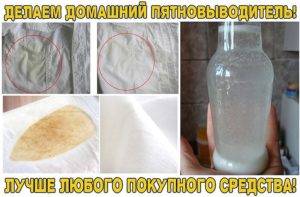
Many families have made a conscious decision to limit their exposure to chemicals. Many cleaning products, including stain removers, are not recommended for baby clothes. What's more, factory-made stain removers are more expensive than natural homemade stain removers.
Today we'll talk about how to make a DIY stain remover at home. First, let's talk about the blemish properties of some of the natural ingredients, and then I'll share with you recipes for several homemade stain removers.
By the way, you can also find out how DIY dishwashing and window cleaning products.
For colored and white things - recipe number 1
When using chemical stain removers, there is a possibility of discoloration on the fibers of the fabric. Given this fact, the following composition can be prepared:
- soda ash (3 tbsp. l);
- household soap 72% (2 tbsp. l) grind on a fine grater;
- fresh green tea (0.5 tbsp.) - optional
- 5-7 drops of essential oil (preferably lavender);
- boiling water (1 liter).
- Citric acid can be added to soften the fabric.
- To preserve color longer - sprinkle with a couple of tablespoons of salt.
- If you are washing white cotton items, add 1 tsp before washing. hydrogen peroxide.
Mix all ingredients, bring to a boil and cool. Pour this solution into the washing machine or soak the laundry in it for several hours. Wash and rinse thoroughly.
Caution: Soda ash is alkali, so be sure to wear rubber gloves when hand washing
Bleach kitchen towels - recipe number 2
It is difficult to restore kitchen towels to their original appearance after several times of use. Accordingly, it is easier to replace them with new ones. But some housewives manage to resort to tricks by preparing a bleach with their own hands, which is based on refined sunflower oil.
At first glance, this method is surprising, but once having applied it in a case, housewives really confirm its effectiveness.
- 5 liters of water;
- 0.5 cups of washing powder;
- 1 tablespoon of sunflower oil.
Preparation: Boil water in a large saucepan, add powder and stir. Then add oil. Dip dry, dirty towels in soapy water. This procedure is best done at night so that they have time to soak. The next day, rinse first in clean hot water and then in warm water.
Fact: With this recipe, you can bleach soiled items from tea, coffee, or wine.
Children's washing powder with their own hands - recipe number 3
The borax (sodium borate) blend is a good cleanser as this natural substance has antibacterial and antifungal properties. It is not for nothing that borax is added to baby powders, since it has the ability to cope with heavy dirt and soften fabrics.
Caution: Sodium borate is alkaline, so wear rubber gloves to protect your hands. You can buy it at hardware stores.
Includes:
- dark laundry soap - 150 g;
- baking soda - 500 g;
- borax - 200 g;
- a few drops of essential oil (tea tree).
Three soap on a fine grater. Combine in a small amount of boiling water, add all the other ingredients, stir and use instead of the usual washing powder. You will definitely be satisfied with the quality of the wash. But keep in mind that borax has a bleaching property and is not suitable for washing colored items.
Homemade spray - recipe number 4
The good thing about using this tool is that it can be applied on almost any surface. Washes baby clothes from chocolate, ketchup, carrot and beetroot juice stains, does an excellent job on light textile upholstery.
Components: we take in equal amounts of 50 ml of glycerin, distilled water, liquid soap, 100 ml of hydrogen peroxide 3% and essential lemon oil (40 k). The latter, for short-term storage, can be replaced with the juice of one lemon.
Preparation: thoroughly mix the entire composition in a dark bottle and start processing the contaminated areas.
Attention: homemade detergent is stored for no more than two months
Carpet cleaning - recipe number 5
The solution can be prepared in a spray bottle or in a regular bottle. We pour there:
- a glass of purified water;
- 1 tsp liquid dish detergent;
- one tbsp. l. table vinegar;
- a teaspoon of baking soda.
Home stain remover that works wonders
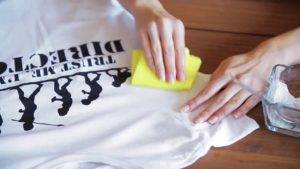
Many families have made a conscious decision to limit their exposure to chemicals. Many cleaning products, including stain removers, are not recommended for baby clothes. What's more, factory-made stain removers are more expensive than natural homemade stain removers.
Today we'll talk about how to make a DIY stain remover at home. First, let's talk about the blemish properties of some of the natural ingredients, and then I'll share with you recipes for several homemade stain removers.
By the way, you can also learn how to make your own dishwashing and window cleaning products.
5 effective homemade stain removers recipes
We offer you to get acquainted with simple but effective recipes that can replace expensive household chemicals
It is important to remember that stain removers are divided into oxygen, acid, solvent and targeted agents. Which one to choose depends on the origin of the stain and the type of fabric
The analogs of oxygen include: hydrogen peroxide, borax, soda ash and baking soda, acidic ones will be replaced - table vinegar, citric acid, ammonia, olive oil, acetone will serve as solvents. Laundry soap, glycerin, salt, green tea, olive oil and aspirin are always in demand in cleaning things.
How to make a stain remover with your own hands at home
No one is immune from accidental dirt: a drop of coffee on a blouse, a trace of grass on the knees, a strip of lipstick on the collar. There are a lot of reasons for the appearance of distressing marks on clothes.
Each spot has its own specifics. It is necessary either to keep a set of tools at hand, like in a dry cleaner, or to be able to solve the problem quickly, using available tools.
How to make a stain remover at home, no less effective than the factory one?
How to make a stain remover at home for specific stains?
In cases where the universal stain removers for certain types of fabrics, prepared by you according to the methods already described, did not help remove the dirt, then you can try using a recipe for making a stain remover with your own hands specifically for your case.
Ink stains
If your student at school wrote too hard and pen marks remained on his clothes, do not swear, it is very easy to get rid of them:
- Make a slurry with baking soda and warm water.
- Rub it into the stain and leave to dry.
- Pour some vinegar over the dried mixture.
- Rinse and wash the product.
You can try to remove ink marks on delicate fabrics with heated glycerin.
Stain remover for removing felt-tip and highlighter stains
Having a little “artist” at home, you are not insured against such contamination:
- Marker stains can be removed with a mixture of salt and lemon juice.
- Ethyl alcohol will remove the permanent marker from your clothes. Just moisten a cotton pad with this substance and scrub the dirt.
Berry and fruit stains
Traces from the absorption of summer "vitamins" can appear not only on children's clothes, but also on adults. Tablecloths and towels also suffer from such contamination. To get rid of berry and fruit juices on fabric:
- You can rub the stain with denatured alcohol, then wash.
- If the dye on the fabric is not durable, then treat the stain with glycerin mixed with egg yolk 1: 1.
Red wine stain
Having noted some significant event, we often notice traces of red wine on our clothes. Do not be upset, the situation can be corrected.
A fresh stain should be blotted with a napkin and treated with a gruel of salt and water. The salt will instantly absorb the remnants of the wine. Then just wash the item.
Blood stains
Troubles can happen to everyone, there are different situations when blood stains remain on clothes. The following tools will help to remove them:
- If the blood stain is fresh, rinse the item under running cold water, and when the main stain has disappeared, wash it by hand with laundry soap.
- If the fabric is white, use hydrogen peroxide diluted with water. Pour the solution over the stain, wait, then rinse, wash.
- Salt and water gruel will also help in this case.
Tea and coffee
Everyone faces similar spots:
- Traces of tea, especially fresh ones, are well removed by gruel, which contains salt and warm glycerin.
- For traces of coffee, a mixture of table salt with ammonia will help.
- Milk coffee can be removed with lighter gasoline.
Foundation and other cosmetics
- Accidentally left traces of bright lipstick can be removed in a very original way by spraying hairspray on the stain. Immediately after such actions, you must wash the item in soapy water.
- Often, foundation, powder and other decorative cosmetics leave marks on the collars of blouses. These stains are perfectly removed with cotton wool and ammonia.
Deodorant
Not all deodorants and antiperspirants are as "traceless" as advertised. Often whitish or yellowish traces remain from them. You can get rid of them like this:
- On light-colored fabrics - using a gruel of cold water and soda (1 tablespoon of soda in 1 glass of water). If there are still traces, you can sprinkle baking soda over the stain and rub. Wash the item after 30 minutes.
- It is better to use another method on dark fabrics. Mix 1 teaspoon of salt with 1 teaspoon of ammonia.After applying such a mixture to the fabric, wait 15 minutes, rinse and wash clothes.
Rust
Moisten the rust stain with lemon juice, then apply a hot iron through cheesecloth, but do not let the stain dry. The procedure should be repeated several times until the result is achieved.
Corrector
Corrector stains are not uncommon on schoolchildren's clothes. If you do not use special products, then they will not go away even after repeated washings:
- If the concealer is water-based, rub the stain with laundry soap and wash.
- Use vodka, rubbing alcohol, tonic or acetone to remove stains from alcohol or emulsion corrector.
- If the proofreader stubbornly doesn't want to wipe it off, try white spirit, gasoline, or another thinner.
Iron marks
Sometimes, setting the wrong temperature regime on the iron, we get the corresponding marks on the fabric. Try to get rid of them like this:
- Pour milk or yogurt on a fresh stain, leave for 1-2 hours, wash with laundry soap.
- If time has passed, try applying onion gruel to it. Rub it well, leave it on for a few hours. Then wash off with cool water.
With these tips, footprints will become invisible.

